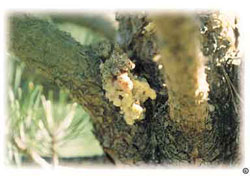Dead and dying branches in the upper half of pine trees may signal Zimmerman pine moth infestation. Austrian pines are most commonly infested, although Scotch and ponderosa pines are also damaged.
Infested branches typically break at the crotch, where they join the trunk. The first external sign of injury is the production of popcorn-like pitch masses at wound sites. They are the size of golf balls and resemble clusters of small, pale colored grapes.
Zimmerman pine moth caterpillars overwinter in cocoons under bark scales. They tunnel into trees in late April and early May and by July, have created noticeable pitch masses. The caterpillars pupate and emerge from cocoons as adults in late July and August. Eggs hatch into the caterpillars that overwinter under the bark.
The moth is most vulnerable during late summer and again in spring when they are exposed and active on the bark. A drenching trunk spray such as permethrin, applied in mid-April and August should kill larvae before they enter trunks.
For more information, see the following Colorado State University Extension fact sheet(s).



